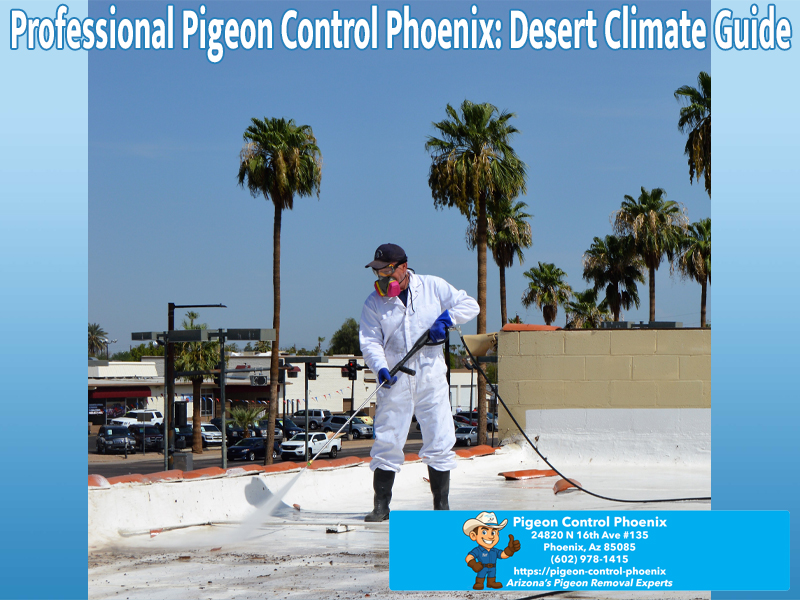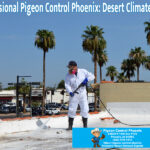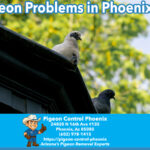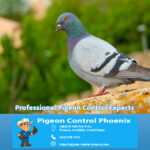Professional Pigeon Control Phoenix : Desert Climate Guide
When most Phoenix homeowners spot a few pigeons roosting on their property, they see a minor nuisance. What they don’t realize is they’re witnessing the beginning stages of a persistent urban wildlife challenge uniquely intensified by Arizona’s desert environment. Unlike cities where seasonal temperature changes naturally discourage pigeon populations, Metropolitan Phoenix’s year-round warmth creates ideal conditions for these adaptable birds to thrive, breed continuously, and establish permanent colonies that escalate from a handful of birds to dozens within months.
Professional pigeon control phoenix experts emphasize the importance of early intervention to mitigate pigeon issues before they escalate into larger infestations.
This is why professional pigeon control phoenix services are essential for homeowners who want to maintain their property and prevent these problems from escalating. Professional pigeon control phoenix is critical for effective management of pigeon populations. Our professional pigeon control phoenix team provides tailored solutions to meet your property’s specific needs.
For over 30 years, we’ve watched Phoenix’s rapid urban expansion create an unintentional pigeon paradise—and we’ve developed specialized knowledge about why standard professional pigeon control phoenix approaches fail in our unique desert climate. This isn’t just about annoying bird droppings; it’s about understanding how desert-adapted pigeons behave differently, why Arizona’s extreme environment demands specialized solutions, and what actually works for lasting professional pigeon control phoenix and prevention in the Valley of the Sun.
Understanding the unique challenges of professional pigeon control phoenix is essential for homeowners who want to protect their property.
The Desert-Adapted Pigeon: Why Phoenix Birds Are Different
Professional Pigeon Control Phoenix Services That Work
Choosing the right professional pigeon control phoenix service can make all the difference in successfully managing and preventing pigeon problems.
Phoenix pigeons have evolved remarkable resilience that makes them fundamentally different from their counterparts in other climates. Through generations of desert living, these birds have developed behaviors and survival strategies that render most conventional deterrents completely ineffective.
Why Common Deterrents Fail Within Weeks
Property owners frequently purchase plastic owls, reflective tape, or motion-activated devices expecting immediate relief. What typically happens tells a different story. During the first few days, pigeons exhibit wariness—cautiously avoiding areas where these new objects appear. However, desert-adapted pigeons possess exceptional learning abilities honed by survival in harsh environments.
Within 7-14 days, most pigeons recognize these static deterrents as harmless. We’ve documented cases where pigeons roosted directly atop plastic owl decoys, completely comfortable with objects that initially seemed threatening. The problem compounds because once pigeons learn a deterrent is fake, they become even more resistant to future control attempts, having been “trained” that threats in this location aren’t real.
Because professional pigeon control phoenix services understand local bird behavior, they can implement strategies that yield long-lasting results.
Reflective tape and spinning devices degrade rapidly under Arizona’s intense UV exposure. What might work for months in Seattle or Portland loses effectiveness within weeks here. The sun bleaches colors, brittles plastic, and weakens adhesives—transforming your deterrent into roosting decoration. By the time you notice it’s no longer working, pigeons have already established nesting behaviors they’ll defend aggressively.
The Learning Curve That Costs Property Owners
Many property owners are unaware of how professional pigeon control phoenix can transform their environments.
Desert pigeons demonstrate sophisticated problem-solving that surprises many property owners. They observe patterns—when humans are present, when properties are vacant, which areas receive the most foot traffic. They adapt their behavior accordingly, roosting in high-traffic areas during quiet hours and relocating to secondary sites when disturbed.
This intelligence means each failed deterrent attempt actually makes your pigeon problem harder to solve. The birds learn your property is “safe” despite apparent threats, communicate this to flock members through behavior modeling, and become increasingly bold. What started as a few cautious birds testing your roof transforms into an established colony confident in their territorial claim.

Solar Panel Pigeon Proofing Phoenix Arizona
Phoenix’s Solar Panel Boom: An Unintended Pigeon Infrastructure
When addressing pigeon colonies, professional pigeon control phoenix specialists focus on prevention and safe trapping methods.
Phoenix leads the nation in residential solar panel adoption—an environmental victory that inadvertently created thousands of ideal pigeon nesting habitats across the Valley. Understanding this connection explains why solar panel pigeon-proofing has become one of our most requested services.
The Perfect 8-Inch Nesting Gap
Solar panel installations create a sheltered space approximately 8 inches high between the panel surface and your roof—precisely the dimensions pigeons prefer for nesting. This gap provides:
-
- Protection from predators: Hawks and other natural pigeon predators cannot access the confined space
Effective professional pigeon control phoenix solutions include regular maintenance and monitoring.
- Shade from extreme heat: Critical in Phoenix’s 115°F+ summer temperatures
- Shelter from monsoon rains: Keeping nests dry during July-September storms
- Concealment: Hidden from human view, allowing undisturbed breeding
- Elevated position: Providing the high vantage points pigeons instinctively seek
Once pigeons discover this perfect nesting environment, they return year after year, often bringing offspring who learn the location as their birthplace. A single solar installation can host multiple breeding pairs simultaneously, with each pair producing 4-6 clutches annually in Phoenix’s year-round breeding climate.
The Efficiency and Safety Consequences
Pigeon activity beneath solar panels creates measurable impacts that extend beyond aesthetics:
Energy Efficiency Loss: We’ve documented efficiency decreases ranging from 15-35% on heavily infested systems. Accumulated droppings on panel surfaces block sunlight transmission, while debris beneath panels restricts airflow necessary for cooling. In Phoenix’s intense heat, solar panels already operate at reduced efficiency when temperatures exceed optimal ranges—adding pigeon-related obstructions compounds these losses significantly.
By utilizing professional pigeon control phoenix services, property owners can enjoy a cleaner and safer outdoor environment.
Fire Hazards: Nesting materials—dry grass, twigs, feathers, and debris—accumulate in spaces designed for ventilation. When combined with electrical components operating at high temperatures, this creates genuine fire risks. We’ve responded to properties where homeowners discovered smoldering nesting materials during routine inspections, narrowly avoiding serious incidents.
Long-term benefits of investing in professional pigeon control phoenix include improved property value and aesthetics.
Equipment Damage: Acidic pigeon droppings corrode mounting hardware, degrade waterproof sealing, and etch panel surfaces. Repair costs often exceed the investment in proper pigeon-proofing, especially when warranty-voiding damage occurs from amateur removal attempts.
Warranty Concerns: Most solar installation warranties explicitly prohibit certain pigeon control methods. Drilling into panels or mounting hardware, applying adhesives directly to equipment, or causing any modification typically voids manufacturer warranties worth thousands of dollars. Professional pigeon control specialists understand these limitations and implement solutions that maintain warranty compliance.

Year Round Pigeon Breeding Phoenix Arizona
Why Incomplete Solutions Create Bigger Pigeon Problems
The most common mistake Phoenix property owners make isn’t attempting pigeon control—it’s implementing partial solutions that address visible symptoms while ignoring root causes. This approach consistently transforms manageable situations into entrenched infestations.
Trusting professionals for pigeon control phoenix ensures humane treatment of wildlife while solving your pigeon problems.
The Nest Removal Cycle
Discovering an active pigeon nest triggers an understandable impulse: remove it immediately. However, nest removal without comprehensive exclusion creates a frustrating cycle:
Day 1: You remove the nest, disposing of materials and cleaning the area
Days 2-5: Pigeons begin rebuilding, often in the exact same location
Days 6-10: New nest reaches functional size, eggs appear
Days 11-30: Breeding cycle completes, fledglings join the flock
Month 2: Multiple nests appear as the original pair continues breeding while offspring mature
Each cycle strengthens the pigeons’ territorial attachment to your property. They’ve invested significant energy in this location and become increasingly aggressive about defending it. The biological drive to return to successful breeding sites means casual nest removal never solves the underlying problem—it merely delays the inevitable while the colony grows.
The Bird Spike Misconception
With professional pigeon control phoenix, the focus is on creating environments that are less attractive to pigeons.
Bird spikes represent one of the most misunderstood pigeon control products. When properly installed by professionals using quality materials and appropriate placement, they effectively prevent roosting on ledges, signs, and architectural features. However, improper DIY installation creates serious problems:
Inadequate Coverage: Property owners often install spikes only on obvious roosting spots, leaving gaps that pigeons exploit. Birds simply shift to adjacent unprotected areas, sometimes just inches away from spiked surfaces.
Poor Quality Materials: Hardware store bird spikes frequently use plastic bases and thin metal wires that Phoenix’s sun degrades rapidly. UV exposure brittles plastic, causing spikes to detach during winds. Thin wires bend under pigeon weight, creating ineffective barriers that birds navigate easily.
Improper Spacing: Spike effectiveness depends on precise spacing that prevents pigeons from landing between rows. Too-wide spacing allows birds to roost comfortably between spikes. Too-narrow spacing wastes materials and increases costs without improving effectiveness.
Injury Concerns: Sharp, poorly installed spikes can injure birds without discouraging them—creating ethical concerns and potentially violating Arizona wildlife regulations. Injured birds may die slowly, creating odor issues and attracting scavengers. Responsible pigeon control prioritizes humane methods that exclude birds without causing harm.
False Security: Property owners who install inadequate spike systems believe they’ve “solved” the problem, delaying proper professional intervention while pigeons establish deeper infestations in unprotected areas.
Chemical Repellents in Desert Heat
Chemical repellents marketed for pigeon control face unique challenges in Phoenix’s extreme environment. Products designed for moderate climates evaporate rapidly in 110°F+ temperatures, requiring frequent reapplication that becomes cost-prohibitive. The intense UV radiation also degrades active ingredients, reducing effectiveness within days of application.
The approach to professional pigeon control phoenix is informed by the specific characteristics of the local pigeon populations.
Additionally, chemical repellents rarely address the fundamental question: why are pigeons attracted to your property? Without identifying and eliminating attractants—food sources, water access, ideal roosting sites—repellents provide only temporary displacement, pushing birds to nearby areas until the chemical dissipates and they return.
Arizona’s Climate: Why Standard Materials Fail
Phoenix’s environmental extremes demand specialized materials and installation methods that standard pigeon control products simply cannot withstand. Understanding these climate challenges explains why professional-grade, desert-proof solutions deliver 5-10+ years of protection while consumer products fail within months.
UV Degradation Accelerates Material Breakdown
Arizona receives among the highest annual UV radiation levels in the United States. This constant bombardment accelerates photodegradation—the process where UV light breaks molecular bonds in plastics, adhesives, and coatings.
Standard bird netting made from nylon or polyethylene becomes brittle within 6-12 months of Phoenix sun exposure. The material loses flexibility, develops stress cracks, and eventually tears under wind pressure or accumulated debris weight. We’ve removed countless failed netting installations where property owners invested hundreds in materials that disintegrated before pigeons abandoned the site.
Professional-grade netting uses UV-stabilized polymers specifically formulated for desert climates. These materials incorporate UV inhibitors that absorb and dissipate radiation without molecular damage, maintaining strength and flexibility for 7-10 years even under constant sun exposure.
Having professional pigeon control phoenix services means that property owners receive tailored solutions designed for their unique situations.
Adhesives present similar challenges. Consumer-grade products lose bonding strength as UV exposure degrades chemical compounds. Adhesive-mounted deterrents detach during summer heat or monsoon winds, creating safety hazards and rendering protection ineffective. Professional installations use mechanical fastening systems that don’t rely on adhesives, or utilize commercial-grade adhesives rated for extreme temperature ranges (-40°F to 180°F) that Phoenix surfaces regularly experience.
Temperature Extremes Test Material Limits
Phoenix surface temperatures frequently exceed 160°F on summer afternoons—far beyond the design parameters of most consumer products. Roof surfaces, solar panels, and metal fixtures reach temperatures that soften plastics, melt adhesives, and warp structural components.
We’ve documented:
Beyond aesthetics, professional pigeon control phoenix helps maintain the structural integrity of your building.
- Plastic bird spikes sagging and losing their deterrent shape
- Adhesive-mounted products sliding down vertical surfaces as glue liquefies
- Reflective tape curling and detaching as backing adhesive fails
- Electronic deterrent housings cracking from thermal cycling
Professional solutions account for these extremes. Stainless steel components withstand temperature variations without degradation. PVC-coated steel mesh maintains structural integrity across Phoenix’s temperature range. Mounting systems use stainless steel hardware designed for commercial roofing applications where temperature resistance is critical.
Monsoon Season Adds Wind and Water Stress
July through September brings powerful thunderstorms with winds exceeding 50 mph, intense rainfall, and occasional hail. These monsoon conditions test every aspect of pigeon control installations:
Wind Loading: Improperly secured netting acts as a sail, creating tremendous force against mounting points. Consumer-grade installations frequently fail during monsoon season as inadequate anchoring pulls free from building surfaces. Professional installations calculate wind loads and use commercial-grade anchoring systems rated for hurricane-force winds.
Water Infiltration: Rain exposure reveals quality differences immediately. Low-grade netting develops mildew and biological growth that weakens fibers. Cheap metal components rust despite “rust-resistant” marketing claims. Professional materials use true stainless steel (not just coated steel) and antimicrobial treatments preventing biological degradation.
Thermal Shock: Rapid temperature drops during monsoon storms—sometimes 30+ degrees within an hour—stress materials through thermal contraction. Repeated cycling causes fatigue failures in marginal installations. Quality materials maintain elasticity across temperature ranges, preventing stress cracking.
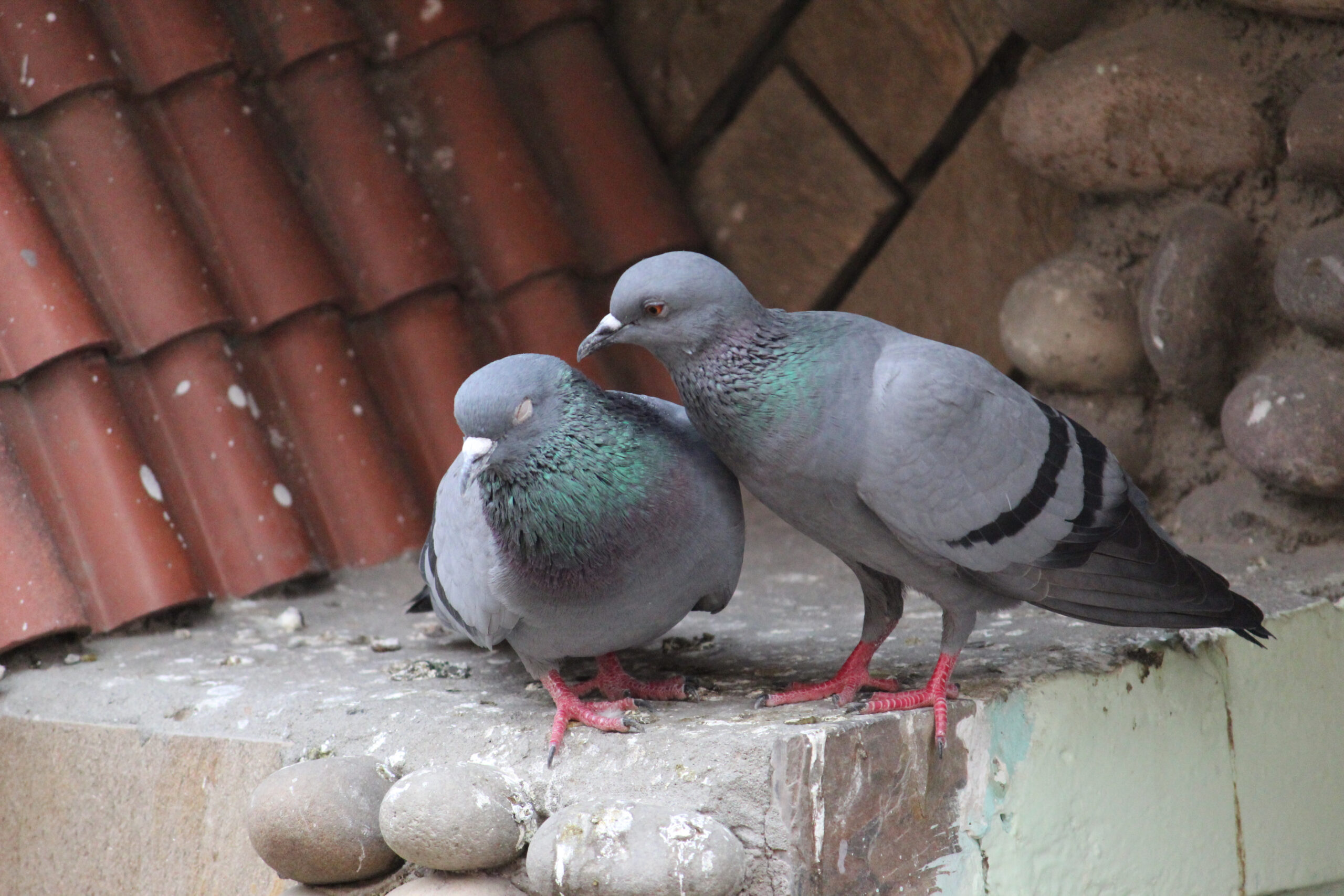
Phoenix Pigeon Control DIY vs Professional Pigeon Control
The Property Assessment Difference: Uncovering Hidden Attractants
Every Phoenix property presents unique pigeon challenges influenced by architectural design, landscaping, nearby development, and dozens of site-specific factors that generic solutions overlook. This is why comprehensive property assessment forms the foundation of effective pigeon control.
For effective management, professional pigeon control phoenix relies on in-depth property assessments.
Architectural Features That Welcome Pigeons
Building design significantly influences pigeon attractiveness, often in ways property owners never consider:
Ledges and Overhangs: Horizontal surfaces 6+ inches wide provide ideal roosting platforms. Buildings with decorative ledges, deep eaves, or architectural details create multiple attractive perching sites. Professional assessment identifies every potential roosting surface, developing comprehensive exclusion strategies rather than addressing only the most obvious spots.
Understanding how to navigate environmental factors is critical for professional pigeon control phoenix strategies.
Recessed Areas: Alcoves, covered entryways, and equipment enclosures offer sheltered spaces pigeons prefer for nesting. These protected areas maintain more moderate temperatures and shield birds from weather—making them prime nesting real estate.
Building Height and Exposure: Pigeons prefer elevated positions offering unobstructed views. Taller buildings, particularly those isolated from nearby structures, attract roosting behavior. Assessment considers sight lines and exposure patterns when developing control strategies.
Material Choices: Certain building materials provide better grip for pigeon feet. Rough concrete, exposed aggregate, and textured stucco offer excellent traction. Smooth metal and glass surfaces prove less attractive but don’t prevent determined birds from roosting nearby.
Water Sources in the Desert
In Phoenix’s arid environment, accessible water becomes a powerful pigeon attractant that many property owners overlook:
Irrigation Systems: Drip lines, spray heads, and timer-controlled systems provide predictable water access. Pigeons learn irrigation schedules, arriving consistently at watering times. Leaking valves or damaged lines create standing water that attracts flocks.
Pool and Spa Areas: Backyard pools serve as massive bird baths. Pigeons perch on coping, drink from the pool surface, and often defecate in the water—creating sanitation concerns and increasing chemical demand.
AC Condensation: Air conditioning units produce significant condensation during Phoenix summers. Drip pans and drain lines provide consistent water sources that pigeons exploit, particularly during the hottest months when natural water is scarce.
Professional pigeon control phoenix addresses long-term challenges rather than just immediate concerns.
Pet Water Bowls: Outdoor pet water dishes, bird baths intended for songbirds, and decorative fountains all attract pigeons. Many property owners inadvertently create pigeon-friendly environments while attempting to welcome other wildlife.
Rain Runoff Patterns: Even in our dry climate, monsoon season creates temporary water accumulation in low spots, clogged gutters, and improper drainage areas. Pigeons remember these locations and return during wet periods.
Food Source Identification
Identifying food sources is a key component of professional pigeon control phoenix services.
Understanding what feeds local pigeon populations reveals attractants that must be addressed for lasting control:
Landscape Choices: Fruit trees, seed-bearing plants, and flowering species that produce edible seeds attract pigeons. Citrus trees common in Phoenix landscaping drop fruit that pigeons consume. Desert landscaping with seed-producing native plants inadvertently provides food supplies.
Outdoor Dining Areas: Restaurant patios, employee break areas, and residential outdoor kitchens generate food waste and crumbs that support pigeon populations. Improper waste container management allows birds easy access to abundant food sources.
Neighboring Properties: Your pigeon problem may originate from attractants on adjacent properties—community pools, restaurants, parks, or even neighbors who actively feed birds. Comprehensive assessment considers the broader environment, not just your immediate property.
Bird Feeders: Property owners who feed songbirds unknowingly feed pigeons. Spilled seed on the ground and easily accessed feeders become pigeon cafeterias. Assessment includes recommendations for bird feeding practices that minimize pigeon attraction while maintaining songbird support.
Site-Specific Environmental Factors
Beyond obvious attractants, environmental context influences pigeon behavior in ways that require local expertise to identify:
Proximity to Established Roosts: Pigeons typically forage within a 1-2 mile radius of roosting sites. Properties near established pigeon colonies face greater pressure than isolated locations. Assessment considers neighborhood pigeon populations when developing control timelines and strategies.
Incorporating local knowledge into professional pigeon control phoenix strategies leads to more effective outcomes.
Flight Path Positioning: Pigeons follow consistent flight paths between roosting, feeding, and watering sites. Properties positioned along these routes experience more landing attempts than properties located away from regular pigeon traffic.
Shelter from Prevailing Winds: Phoenix’s prevailing southwest winds influence where pigeons prefer to roost. South and west-facing building areas receive more sun and wind exposure. North and east-facing areas offer cooler, calmer conditions that pigeons favor—particularly during summer months.
Natural Predator Presence: Properties near hawk nesting sites or regular hawk hunting grounds experience reduced pigeon pressure due to predation risk. Assessment considers whether natural predator activity provides partial control that professional methods can enhance.
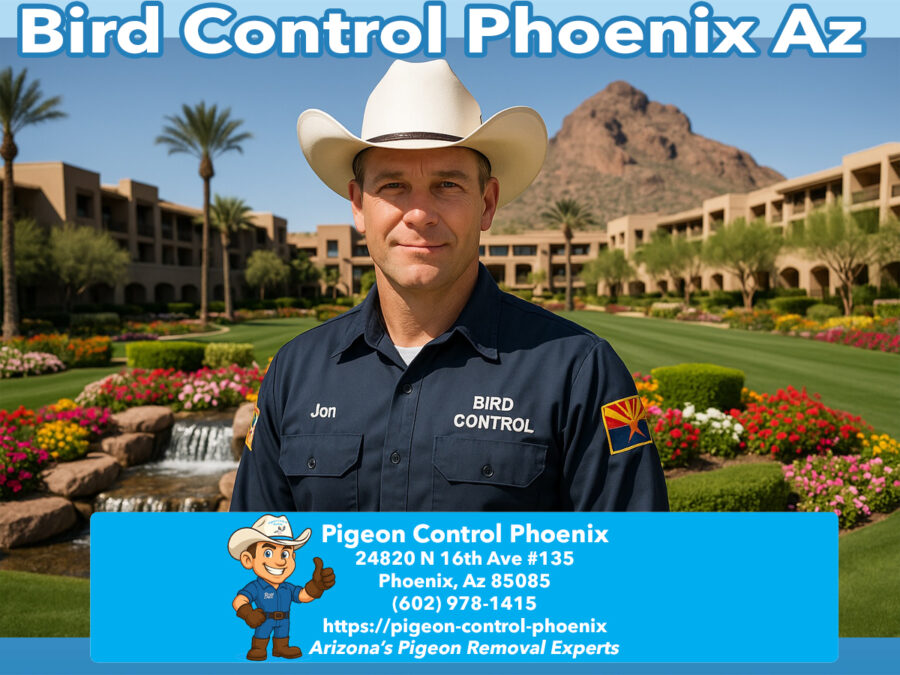
Bird Control Phoenix Az | Bird Removal Phoenix Az
The Professional Path Forward: Comprehensive, Ethical, Lasting Solutions
After three decades of pigeon control experience specific to Phoenix’s desert environment, we’ve refined an approach that delivers results where DIY methods and generic solutions consistently fail. Our process addresses root causes, implements desert-proof materials, and provides ongoing support ensuring long-term success.
Step 1: Thorough Property Evaluation
Every effective pigeon control project begins with comprehensive assessment by experienced technicians who understand Phoenix-specific challenges. This isn’t a quick walk-around—it’s a systematic evaluation of your entire property including:
-
- Identification of all current roosting and nesting sites
By focusing on comprehensive evaluations, professional pigeon control phoenix services can identify the most effective strategies.
-
- Documentation of pigeon population size and behavior patterns
- Analysis of architectural features creating pigeon-friendly conditions
- Assessment of water sources and food availability
- Evaluation of nearby environmental factors influencing pigeon pressure
Professional pigeon control phoenix specialists are trained to address specific local challenges effectively.
- Photography documenting current conditions for comparison after treatment
- Measurement of areas requiring exclusion materials
- Identification of any prior control attempts and why they failed
This detailed assessment provides the foundation for customized solutions addressing your specific situation rather than applying one-size-fits-all methods.
The evolving nature of pigeon behavior necessitates ongoing adaptations in professional pigeon control phoenix techniques.
Step 2: Customized Solution Design
Based on assessment findings, we develop comprehensive strategies combining multiple approaches:
Physical Exclusion: Professional-grade bird netting, PVC-coated steel mesh screening for solar panels and equipment, stainless steel spike systems properly spaced and installed, and bird wire systems for ledges and signs—all using materials specifically rated for Arizona’s extreme UV and temperature conditions.
Humane Removal: When active infestations exist, we provide safe, ethical pigeon removal following Arizona wildlife regulations. This includes live trapping and relocation when appropriate, or population reduction methods that minimize suffering and comply with legal requirements.
Sanitization and Cleanup: Professional cleaning of affected areas using hospital-grade disinfectants, proper disposal of contaminated materials according to Arizona regulations, treatment of surfaces to eliminate odors that might attract returning birds, and restoration recommendations for damaged building materials.
Attractant Elimination: Guidance on landscape modifications reducing food availability, irrigation system adjustments minimizing water access, waste management improvements preventing food source access, and architectural modifications addressing identified vulnerabilities.
For lasting results, professional pigeon control phoenix integrates both prevention and intervention strategies.
Step 3: Expert Installation Using Desert-Proof Materials
Professional installation makes the difference between solutions that last years versus weeks:
Material Selection: Every component selected specifically for Phoenix’s climate—UV-stabilized polymers, true stainless steel (not coated), commercial-grade adhesives rated for extreme temperatures, and mechanical fastening systems that don’t rely on adhesives when possible.
Installation Techniques: Proper tension and securing of bird netting prevents sagging and wildlife entanglement, strategic spike placement with correct spacing for effective exclusion, solar panel screening installed without voiding equipment warranties, and mounting methods that don’t damage building materials or create new water intrusion points.
Quality Assurance: Every installation undergoes quality inspection before completion, verification that all identified entry points are properly sealed, testing of physical barriers ensuring pigeons cannot bypass protections, and documentation with photos showing completed work.
Step 4: Ongoing Monitoring and Warranty Support
Effective professional pigeon control phoenix includes ongoing support to maintain the success of the treatment plan.
Professional pigeon control doesn’t end at installation—it includes commitment to lasting results:
Follow-Up Inspections: Scheduled revisits confirming pigeons have not found bypass routes, verification that installed materials maintain effectiveness, early detection of any new pigeon activity requiring adjustment, and seasonal checks before monsoon and nesting seasons.
Warranty Protection: Comprehensive warranties covering material defects and workmanship, guaranteed response if pigeons return to treated areas, and renewable coverage options for ongoing peace of mind.
Adaptive Solutions: Willingness to modify approaches if initial strategies prove insufficient, adding supplemental deterrents if pigeon pressure exceeds initial assessments, and responding to changing conditions on your property or neighboring areas.
Take the Next Step: Partner With Phoenix’s Pigeon Control Specialists
Pigeon problems in Phoenix demand more than generic solutions and DIY attempts. They require understanding of desert-adapted bird behavior, knowledge of how Arizona’s extreme climate affects control materials, expertise in identifying property-specific attractants, and commitment to humane, effective, lasting solutions.
For over 30 years, Pigeon Control Phoenix has protected Valley properties from pigeon infestations using approaches specifically developed for our unique desert environment. We’ve seen every pigeon challenge Phoenix presents—from solar panel nesting to commercial building infestations, from residential roof invasions to HOA-wide pigeon pressure.
For effective professional pigeon control phoenix, it’s essential to understand local regulations and best practices.
Our local expertise means you’re working with specialists who understand:
- Why standard deterrents fail within weeks in Phoenix sun
- How to pigeon-proof solar panels without voiding warranties
- Which materials actually withstand 115°F+ temperatures
- How to identify hidden attractants generic solutions miss
- What Arizona regulations require for legal, humane pigeon control
Contact Pigeon Control Phoenix today for a comprehensive property assessment. Our experienced technicians will evaluate your specific situation, identify all contributing factors, and develop customized solutions that deliver lasting results—not temporary relief.
Professional Pigeon Control and Removal. Stop fighting the same pigeon battles repeatedly. Partner with Phoenix’s pigeon control specialists who understand the unique challenges our desert environment presents—and know exactly how to solve them permanently.
Your pigeon-free property is one phone call away. Make it today!
Engaging with professional pigeon control phoenix ensures a comprehensive, ethical, and effective approach to pigeon management.
Call (602) 978-1415 or text 24/7 at (602) 786-7386 to schedule your consultation.
Make the decision today to invest in professional pigeon control phoenix and enjoy a cleaner, safer environment.
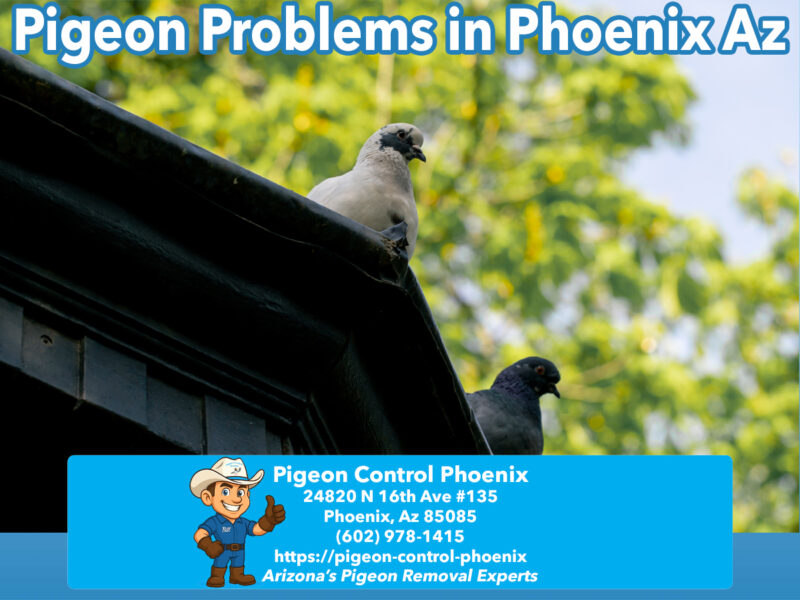
Desert Adapted Pigeons Phoenix Removal
Related Content:
- How to Get rid of Pigeons
- Pigeons Nesting Under Solar Panels
- Solar Panel Pigeon Proofing
- Pigeon Control Arizona
- Pigeon Control Service
- Pigeon Removal
- Pigeon Nuisance
- Pigeons around Solar Panels
- Get rid of Pigeons
- Best Pigeon Control Company
- Cost to Pigeon Proof Solar Panels
- Pigeon Sounds, Cooing and Calls
- Bird Control Phoenix
- Bird Pest Control
- Bird Nest Removal
- How can I get rid of unwanted birds?
- Why You Shouldn’t Feed Pigeons
- Bird Removal Phoenix Az
- Solar Panel Pigeon Proofing
- HVAC Pigeon Removal and Exclusion
- Professional Pigeon Control Experts
- Pigeon Problems
- Professional vs DIY
